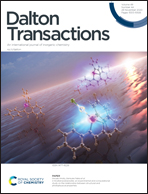Modulating the optical and magnetic properties of geometrically frustrated ZnV2O4 by the introduction of indium (nonmagnetic ions), iron, and chromium (magnetic ions)†
Abstract
The current study is aimed at understanding the effects of diluting the magnetic properties of a geometrically frustrated normal spinel, ZnV2O4, with the incorporation of nonmagnetic In3+ in place of V3+. Samples with the formula, ZnV2−xInxO4 (x = 0.00, 0.25, 0.50, 1.00 and 1.50), were synthesized following an epoxide mediated gel method and characterized extensively. The monophasic cubic spinel structure was retained up to 50 mol% of vanadium with indium, beyond which phase separation took place. The occupancy of indium at the octahedral site and the near-linear increment of the cubic unit cell constant were confirmed from the successful structural refinements. The optical bandgap increased from 2.80 (ZnV2O4) to 3.06, 3.19, and 3.35 eV for x values of 0.25, 0.50, and 1.00 in ZnV2−xInxO4. ZnVInO4 exhibited paramagnetic behavior down to 2 K in both the field-dependent and temperature-dependent magnetic measurements. However, the magnetization values were lower than those of ZnV2O4. A frustration index of 42 was estimated for ZnVInO4. Samples containing magnetic Cr3+ and Fe3+ ions in place of V3+ were synthesized and characterized to compare and contrast the magnetic ions’ influence. For both chromium and iron substituted samples, the optical bandgap was higher than that of ZnV2O4. ZnVCrO4 showed an antiferromagnetic ordering of spins with a TN of 12.3 K. In contrast, the randomization of Zn, V, and Fe among the available crystallographic sites increased the ferrimagnetic transition temperature (TF) to 31.9 K. ZnVInO4 catalyzed the photodegradation of rhodamine-6G under UV-vis radiation to a greater extent than ZnVCrO4 and ZnVFeO4.



 Please wait while we load your content...
Please wait while we load your content...